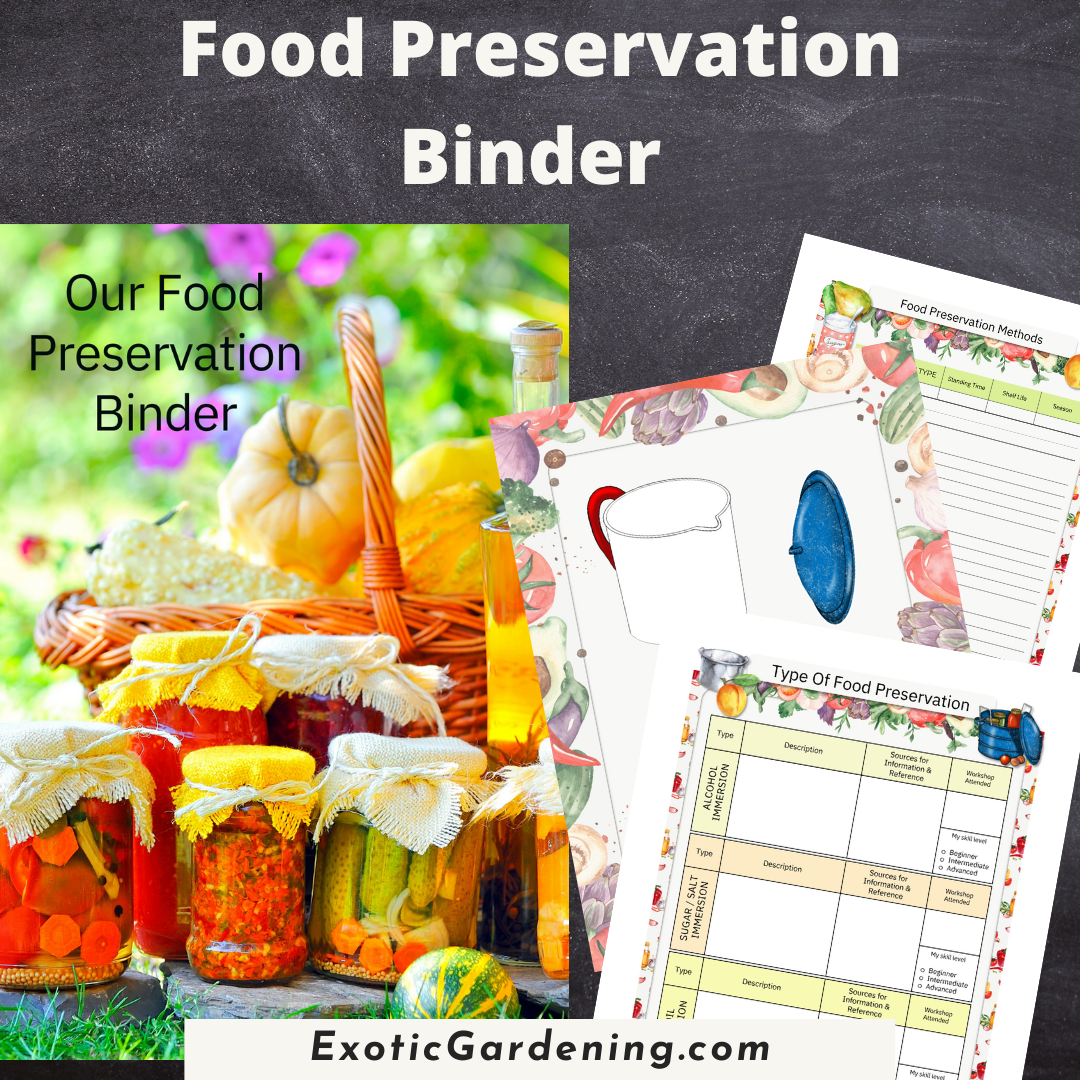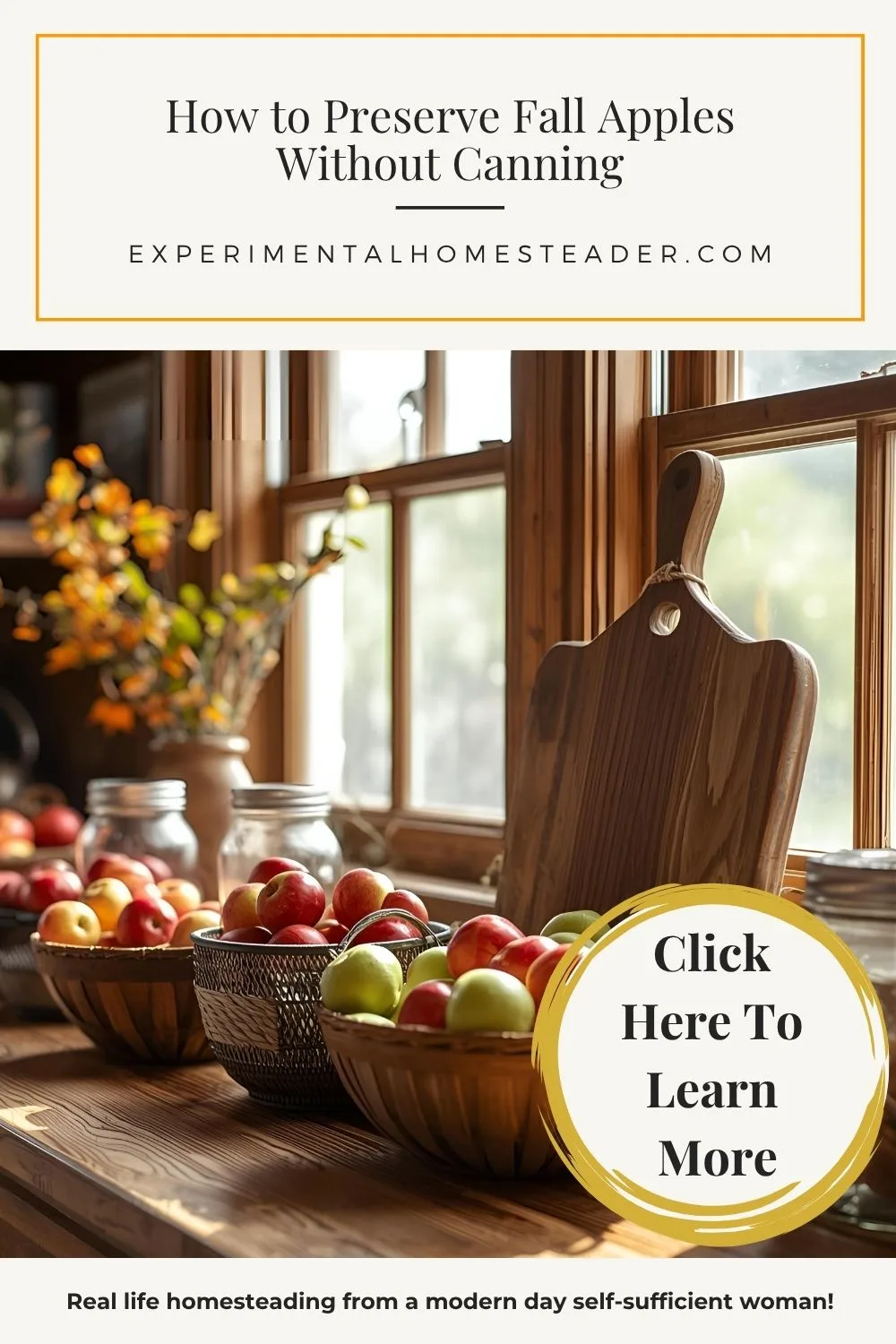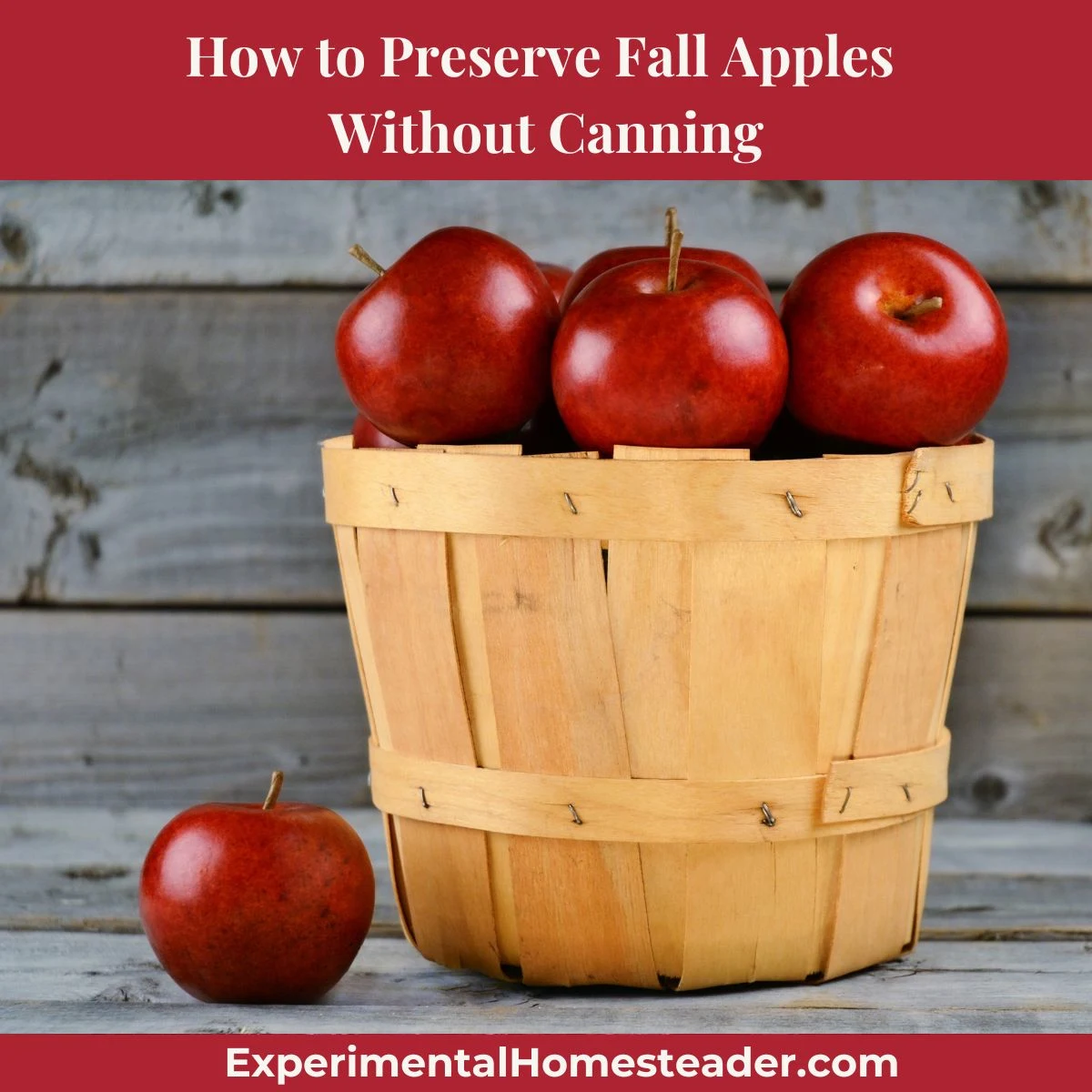Fall apples are one of my favorite seasonal treats, but not everyone wants to drag out the canner to enjoy them all year long.
The good news?
You don’t have to!
There are plenty of simple, effective ways to preserve fall apples without canning - and they taste just as delicious months later.
From freezing apple slices and making slow-cooker apple butter to drying crisp apple chips for snacks, these techniques are quick, easy, and perfect for busy homesteaders.
In this post, I’ll share my favorite no-canning apple preservation methods, plus a few pro tips to keep your apples fresh and flavorful well into winter.
And if you’re ready to organize your seasonal preserving projects, be sure to grab my Food Preservation Planner - it’ll make your kitchen planning a breeze.
You can preserve fall apples without canning by freezing, drying, or turning them into apple butter or applesauce to store in the refrigerator or freezer. Freeze sliced apples in single layers to prevent sticking, dehydrate them into chewy apple chips for shelf storage, or make slow-cooked apple butter that freezes beautifully for long-term use. Each of these methods keeps the flavor of fall apples fresh and delicious without the need for a canner.
Why Skip the Canner?
Now, don’t get me wrong - I love a good canning session when I have the time.
But sometimes life on the homestead gets busy, and the thought of washing, sterilizing and canning jars of food for hours just isn’t appealing.
If you’ve ever been there, you’ll appreciate these reasons to go no-can:
-
Less work, less cleanup. You can preserve smaller batches whenever you have time without committing to a full canning day.
-
No fancy gear required. All you need is your freezer, oven, or dehydrator.
-
Perfect for beginners. These methods are easy enough that even first-time preservers can succeed.
-
Better texture for certain uses. Frozen or dried apples often hold their flavor and shape better than canned ones in baking.
So if you’ve been putting off apple preservation because of the canner, this is your sign to try something different.
1. Freezing Apples - The Easiest Way to Preserve Fall Apples
If I had to pick one method for convenience, freezing apples wins every time.
It works beautifully for both fresh eating and baking later.
How To Freeze Apple Slices
-
Choose firm apples. Crisp, tart varieties like Granny Smith, Honeycrisp, or Jonathan hold up best.
-
Wash, peel, and slice. You can leave the peels on if you like them - they’ll soften during cooking later.
-
Prevent browning. Soak the slices for a few minutes in a mix of 1 tablespoon lemon juice to 2 cups water.
-
Flash freeze. Spread the slices in a single layer on a parchment-lined baking sheet and freeze until solid.
-
Package and label. Transfer to freezer bags, squeeze out extra air, label with the date and apple type, and freeze.
Frozen apples are perfect for pies, crisps, pancakes, and even smoothies.
I’ve also frozen chunky applesauce or apple butter in small containers - just remember to leave about an inch of headspace because liquids expand when they freeze.
Storage life: Up to 10 months when kept at 0°F or below.
2. Drying Apples - Sweet, Chewy, and Shelf-Stable
There’s something magical about the smell of apples drying - it fills the whole kitchen with warm, cinnamon-spiced fall air.
Dehydrating is one of my favorite ways to preserve apples because it doesn’t take up freezer space and makes a healthy, shelf-stable snack.
How To Make Dried Apple Rings or Chips
-
Wash and slice evenly. Aim for slices about ⅛ to ¼ inch thick.
-
Optional: soak in lemon water for 5–10 minutes to reduce browning.
-
Arrange in a single layer. Use dehydrator trays or baking sheets if using your oven.
-
Dry slowly. Set the dehydrator to 125–135°F or bake at your oven’s lowest setting with the door cracked slightly.
-
Check for doneness. They’re ready when pliable but not sticky - or crisp if you prefer apple chips.
-
Condition and store. Let them cool completely, then store in airtight jars or vacuum-seal bags in a cool, dark place.
Dried apples keep for up to a year and are great for snacking, trail mix, or topping oatmeal.
I’ve even ground them into powder to use in spice blends or homemade apple-cinnamon sugar.
It’s a fun way to stretch your harvest.
3. Making Apple Butter (Without Canning)
Slow-cooker apple butter is the ultimate “set it and forget it” recipe - and the smell alone is worth it.
The best part?
You don’t need to can it.
You can simply refrigerate or freeze it.
My Lazy Day Apple Butter Method
-
Fill your slow cooker with chopped apples. Leave the peels on - they add flavor and natural pectin.
-
Add a splash of water or cider. About half a cup is plenty to prevent sticking.
-
Season it up. I like cinnamon, cloves, and a touch of nutmeg. Add sugar or honey if you prefer sweeter butter.
-
Cook low and slow. Let it simmer for 8 to 10 hours, stirring every so often.
-
Blend smooth. Use an immersion blender right in the crock.
-
Cool and store. Spoon into jars, cool completely, then refrigerate or freeze.
This method gives you a thick, deeply flavored apple butter that tastes like autumn in a jar - no canner needed.

Keep Your Preservation Projects Organized All Season Long
Homesteading life moves fast — especially when the harvest rolls in. My Food Preservation Binder is designed to keep you on track so nothing goes to waste.
Inside, you’ll find printable checklists, recipe pages, and logs for canning, freezing, dehydrating, fermenting, and more. Whether you’re freezing apple slices today or planning next week’s batch of sauerkraut, this binder helps you stay organized, efficient, and confident in your kitchen.
✨ What’s Included:
- 5 Printable Types of Food Preservation Planning Sheets
- 2 Printable Equipment Checklists
- 2 Printable Food Preservation Methods Planning Sheets
- 4 Printable Recipe Sheets
- 2 Printable Logs Each for: Canning, Dehydrating, Pickling, Fermenting, and Freezing
- 2 Food Preservation Inventory Sheets
- 2 Food Storage Logs
- 9 Sheets of Print-Then-Cut Food Preservation Stickers
4. Other Creative No-Canning Ideas
If you’re like me, you probably look at a basket of apples and start brainstorming what else you can make.
Here are a few more fun ways to preserve apples without turning on the canner:
-
Homemade apple chips in the oven: Sprinkle slices with cinnamon sugar before drying.
-
Apple syrup: Boil down fresh apple juice until thick and syrupy. Drizzle over pancakes or ice cream.
-
Apple vinegar: Use peels and cores to make your own apple scrap vinegar for cooking and cleaning.
-
Frozen apple pie filling: Mix sliced apples with sugar, flour, and spices. Freeze in pie-sized portions so you can bake a pie any time.
-
Apple chutney or relish: Simmer diced apples with vinegar, onions, and spices - store in the fridge or freeze.
Each of these methods preserves the essence of fall in a way that fits your time, space, and energy levels.
Pro Tips for Success
Here are a few lessons I’ve learned over the years that can make all the difference:
-
Work in small batches. Fresh apples discolor quickly, so don’t try to cut up more than you can handle at once.
-
Label everything. Write the date and variety - it saves so much guessing later.
-
Cool cooked apples fast. Letting them sit too long at room temperature can affect flavor and texture.
-
Avoid freezer burn. Remove air from storage bags and lay them flat in the freezer for even freezing.
-
Use what you have. Even “ugly” or windfallen apples can make fantastic sauce, butter, or dried snacks.
Remember, preservation is all about making what you have last, not about perfection.
Common Questions About Preserving Apples Without Canning
Q: How long do frozen apples last?
Usually about 8 to 10 months in a good, cold freezer.
Q: Can I freeze apples without lemon juice?
You can, but they may brown slightly. The flavor won’t change much, though.
Q: Do I have to peel apples before freezing or drying?
Nope! Peels add color and nutrients. It’s a personal preference.
Q: Can I dry apples in the oven instead of a dehydrator?
Yes! Just keep the oven on its lowest setting and crack the door slightly to let moisture escape.
Q: How do I keep apple butter from separating after freezing?
Stir it well after thawing - it’s normal for a little liquid to form on top.
Enjoying Your Fall Apple Harvest All Year Long
So there you have it - simple, time-saving ways to preserve fall apples without canning.
Whether you freeze, dry, or simmer them into rich, fragrant butter, you’ll have the taste of autumn ready any time you want it.
If you’re like me and love keeping your kitchen organized during harvest season, don’t forget to download the Food Preservation Planner.
It helps you track what’s in the freezer, pantry, or dehydrator so you can make the most of every apple you bring in.
So grab a basket, get those apples ready, and start preserving - your future self (and your winter pantry) will thank you!
🍏 Explore More Apple Inspiration
Keep the apple goodness going! Whether you’re craving dessert, breakfast comfort, or new preservation ideas, these related recipes and guides are perfect for your fall kitchen:
- Apple Canning Recipes
- Homesteaders’ Delight: Slow Cooker Apple-Cinnamon Steel Cut Oatmeal
- Freezing Apples Recipe
- Healthy Dessert Recipes for Apples
- Apple Crisp Dutch Oven Recipe
- Cinnamon Roll Apple Pie Casserole
- Mini Apple Pie Recipe Made with Wonton Wrappers
- The Ultimate Beginner’s Guide to Dehydrating Apples
- Red Hot Apple Wedges Canning Recipe
- Crescent Roll Apple Pie Filling Dessert Recipe
- Apple Crisp Instant Pot Recipe
- Apple Pie for Diabetics
- Caramel Pecan Apple Butter Recipe
- Homemade Apple Cider Recipe
- Cast Iron Apple Crisp Recipe
- Banana Bread Made with Applesauce








